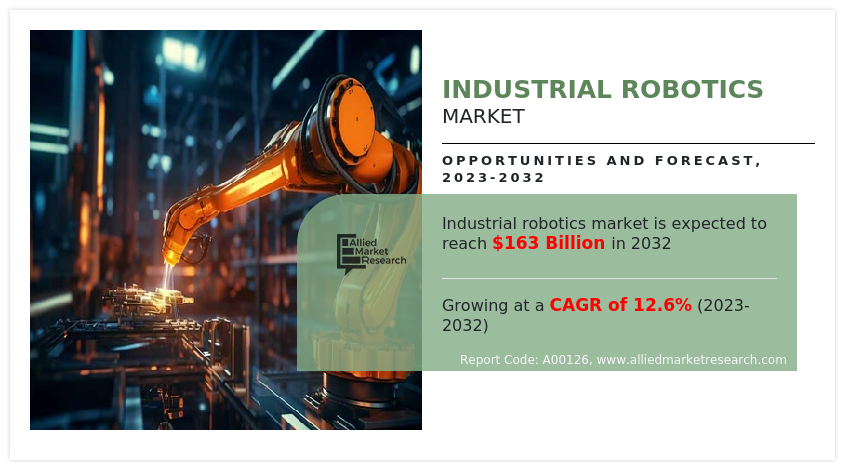
The Rise of Industrial Robotics Market in Automation to Reach $163 billion, at a CAGR of 12.6% from 2023 to 2032

The Asia-Pacific holds the largest share in the market owing to large scale production of industrial robotics.
WILMINGTON, DELAWARE, UNITED STATES, April 25, 2024 /EINPresswire.com/ -- According to a new report published by Allied Market Research, titled, the industrial robotics market size was valued at $38 billion in 2020, and is estimated to reach $163 billion by 2032, growing at a CAGR of 12.6% from 2023 to 2032.
Industrial robotics is a sector that deals with the development, manufacture, and implementation of automated systems and robotic solutions in a variety of industries. These advanced robots are designed to perform a variety of tasks with remarkable accuracy, velocity, and productivity, and are employed in a variety of industrial settings to replace or assist human workers. These robots are employed to improve productivity, reduce safety, and streamline processes in a variety of sectors, including manufacturing, automotive, electronics, logistics, and healthcare.
𝐃𝐨𝐰𝐧𝐥𝐨𝐚𝐝 𝐏𝐃𝐅 𝐒𝐚𝐦𝐩𝐥𝐞 𝐨𝐟 𝐭𝐡𝐢𝐬 𝐑𝐞𝐩𝐨𝐫𝐭 @ 𝐡𝐭𝐭𝐩𝐬://𝐰𝐰𝐰.𝐚𝐥𝐥𝐢𝐞𝐝𝐦𝐚𝐫𝐤𝐞𝐭𝐫𝐞𝐬𝐞𝐚𝐫𝐜𝐡.𝐜𝐨𝐦/𝐫𝐞𝐪𝐮𝐞𝐬𝐭-𝐬𝐚𝐦𝐩𝐥𝐞/𝟐𝟏𝟒
𝐃𝐫𝐢𝐯𝐢𝐧𝐠 𝐃𝐞𝐦𝐚𝐧𝐝𝐬:
Industrial robots are advanced machines built to work in manufacturing and commercial environments, carrying out tasks that might be basic or complicated. These robots can independently carry out tasks such as welding, assembling, packaging, and material handling, owing to the combination of mechanical parts, electronic controls, and software programming used in their construction.
𝐏𝐫𝐢𝐦𝐞 𝐃𝐞𝐭𝐞𝐫𝐦𝐢𝐧𝐚𝐧𝐭𝐬 𝐨𝐟 𝐆𝐫𝐨𝐰𝐭𝐡:
The global industrial robotics market is experiencing growth due to several factors, such as high requirements for automation, high labor costs and a dearth of skilled human workforce, an increase in investments in R&D activities, and the availability of affordable and energy-efficient robots. However, the high initial investment and installation costs and the threat of job displacement may restrain the market growth to some extent. Moreover, the increase in application areas and the evolving robotics and AI industry bring new opportunities for market growt.
𝐁𝐮𝐲 𝐓𝐡𝐢𝐬 𝐑𝐞𝐬𝐞𝐚𝐫𝐜𝐡 𝐑𝐞𝐩𝐨𝐫𝐭 @ 𝐡𝐭𝐭𝐩𝐬://𝐰𝐰𝐰.𝐚𝐥𝐥𝐢𝐞𝐝𝐦𝐚𝐫𝐤𝐞𝐭𝐫𝐞𝐬𝐞𝐚𝐫𝐜𝐡.𝐜𝐨𝐦/𝐜𝐡𝐞𝐜𝐤𝐨𝐮𝐭-𝐟𝐢𝐧𝐚𝐥/𝟖𝟏𝟗𝟔𝟏𝟓𝟏𝟕𝐚𝟖𝟏𝟒𝟒𝐛𝟑𝟔𝐛𝐝𝟔𝟏𝟓𝐛𝟔𝟕𝐚𝟖𝟒𝟔𝟗𝐜𝐟𝐞
The articulated segment to maintain its leadership status throughout the forecast period-
Based on type, the articulated segment held the highest market share in 2020, accounting for more than two-fifths of the global industrial robotics market revenue, and is estimated to maintain its leadership status throughout the forecast period. On the other hand, the cylindrical segment is projected to manifest the highest CAGR of 13.8% from 2023 to 2032. Owing to the high demand for cylindrical robots for pick and place, packaging, assembling-dissembling, and other applications in the warehouse and industrial sector is expected to drive the market.
The electrical and electronics segment to maintain its lead position during the forecast period-
Based on end user industry, the electrical and electronics segment held the highest market share in 2020, accounting for around one-third of the global industrial robotics market, and is estimated to maintain its lead position during the forecast period. This is attributed to the increasing demand for articulated and other robots for miniature work in the electronics and electrical industry. However, the food and beverages segment is projected to manifest the highest CAGR of 13.6% from 2023 to 2032. The rising population is expected to drive the demand for industrial robots in the food and beverages sector.
The materials handling segment to rule the roost by 2032-
Based on function, the materials handling segment accounted for the largest share in 2020, contributing to more than two-fifths of the global industrial robotics market revenue, and is expected to rule the roost by 2032. On the other hand, the painting and dispensing segment is expected to portray the largest CAGR of 14.4% from 2023 to 2032. Growth in automotive, food and beverage, chemical and other industries is increasing demand for industrial robots. Growth in the industrial sector will eventually have a positive impact on the Industrial robotics market.
Asia-Pacific to maintain its dominance by 2032-
Based on region, Asia-Pacific held the highest market share in 2020, accounting for nearly three-fifths of the global industrial robotics market revenue, and is expected to maintain its dominance by 2032. Leading countries like, Japan, India, and Korea are at the forefront of robotics adoption, especially in electronics, and machinery industries. However, the LAMEA region would exhibit the fastest CAGR of 13.8% during the forecast period.
𝐌𝐚𝐤𝐞 𝐀 𝐏𝐮𝐫𝐜𝐡𝐚𝐬𝐞 𝐈𝐧𝐪𝐮𝐢𝐫𝐲: 𝐡𝐭𝐭𝐩𝐬://𝐰𝐰𝐰.𝐚𝐥𝐥𝐢𝐞𝐝𝐦𝐚𝐫𝐤𝐞𝐭𝐫𝐞𝐬𝐞𝐚𝐫𝐜𝐡.𝐜𝐨𝐦/𝐩𝐮𝐫𝐜𝐡𝐚𝐬𝐞-𝐞𝐧𝐪𝐮𝐢𝐫𝐲/𝟐𝟏𝟒
𝐓𝐨𝐩 𝐏𝐥𝐚𝐲𝐞𝐫𝐬:
Panasonic Corporation, KUKA AG, ABB, Mitsubishi Electric Corporation, Kawasaki Heavy Industries, Ltd., Universal Robots A/S, FANUC Corporation, Denso Corporation, Daihen Corporation Co., Ltd., NACHI-FUJIKOSHI CORPORATION (NACHI ROBOTIC SYSTEMS, INC.), Yaskawa Electric Corporation, Seiko Epson Corporation.
𝐊𝐞𝐲 𝐏𝐨𝐢𝐧𝐭𝐬:
The report provides an extensive industrial robotics market analysis of the current and emerging trends and dynamics.
By type, the articulated segment was the largest revenue generator in 2020.
By end user industry, the electrical and electronics segment was the largest revenue generator in 2020.
On the basis of function, the materials handling segment generated the highest revenue in 2022.
Region wise, Asia-Pacific is anticipated to dominate the market throughout the study period.
David Correa
Allied Market Research
+ +1 503-894-6022
email us here
Visit us on social media:
Facebook
Twitter
Other
EIN Presswire does not exercise editorial control over third-party content provided, uploaded, published, or distributed by users of EIN Presswire. We are a distributor, not a publisher, of 3rd party content. Such content may contain the views, opinions, statements, offers, and other material of the respective users, suppliers, participants, or authors.

